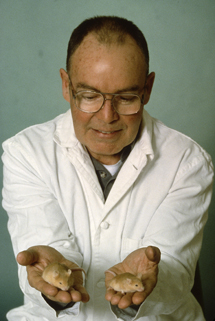Dynamic clustered distribution of hemagglutinin resolved at 40 nm in living cell membranes discriminates between raft theories.
Document Type
Article
Publication Date
2007
Keywords
Cell-Survival, Hemagglutinins, Membrane-Microdomains, Nanostructures
First Page
17370
Last Page
17375
JAX Source
Proc Natl Acad Sci U S A 2007 Oct; 104(44):17370-5.
Abstract
Organization in biological membranes spans many orders of magnitude in length scale, but limited resolution in far-field light microscopy has impeded distinction between numerous biomembrane models. One canonical example of a heterogeneously distributed membrane protein is hemagglutinin (HA) from influenza virus, which is associated with controversial cholesterol-rich lipid rafts. Using fluorescence photoactivation localization microscopy, we are able to image distributions of tens of thousands of HA molecules with subdiffraction resolution ( approximately 40 nm) in live and fixed fibroblasts. HA molecules form irregular clusters on length scales from approximately 40 nm up to many micrometers, consistent with results from electron microscopy. In live cells, the dynamics of HA molecules within clusters is observed and quantified to determine an effective diffusion coefficient. The results are interpreted in terms of several established models of biological membranes.
Recommended Citation
Hess ST,
Gould TJ,
Gudheti MV,
Maas SA,
Mills KD,
Zimmerberg J.
Dynamic clustered distribution of hemagglutinin resolved at 40 nm in living cell membranes discriminates between raft theories. Proc Natl Acad Sci U S A 2007 Oct; 104(44):17370-5.


